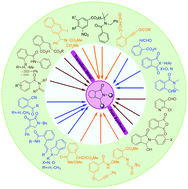Transition metal-free advanced synthetic approaches for isoindolinones and their fused analogues
Abstract
Isoindolinones are the core structures of many natural products and drug molecules and are useful in materials science as fluorescent probes and synthetic dyes. The fused analogues of these blended lactams also have a wide range of applications in medicinal chemistry and chemical biology. Different synthetic approaches and the use of versatile reagents have been reported for the synthesis of these novel molecules. Different research groups have focused their efforts on improving synthetic protocols towards the synthesis of the isoindolinone frame both in the presence and absence of transition metals. However, the transition metal-based pathway requires hazardous conditions, which are toxic to the environment. In particular, the transition metal-free synthetic protocols for isoindolinones and their fused analogues are highly fascinating due to several advantages for the industrial production of these bio-active molecules. These concepts encouraged us to write this review to highlight the recent advancements in the synthetic methods involving transition-metal-free approaches from 2007 to 2021. As the main feature of this review, we summarize the synthetic pathways for the isoindolinones, highlighting the synthetic precursors, which include different ortho-substituted aromatic substrates via multistep or tandem protocols, under metal-free conditions. We also discuss the mechanistic pathway of each methodology for the formation of isoindolinones.

- This article is part of the themed collection: 2022 Focus and Perspective articles


 Please wait while we load your content...
Please wait while we load your content...